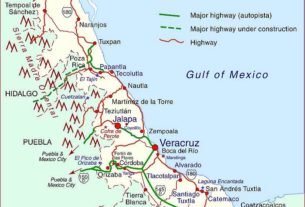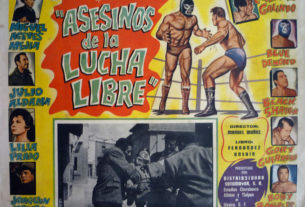At Home in Talpa de Allende, Jalisco
End of year holidays in small Mexican towns in the Sierra Madre mountains and everywhere else have a very special meaning. Folks come home. Milking cows and growing corn or coffee isn’t everybody’s idea of making a good living, so they try to realize their golden dream and head for the cities, but Christmas and Mother’s Day call them back home.

© Howard Mcill, 2006
The highways are bumper-to-bumper with folks coming home to Mexico for Christmas. They are loaded with gifts for everyone. You can spend a few lazy hours sitting in the plaza counting the different foreign-plated cars cruising down the street. Most of our returning visitors come from California or Texas. Occasionally we see an Idaho, Montana or Oregon plate. Once in a while we might see one from British Columbia.
Home folks try to get their holiday decorations up by the 1st of December and they don’t come down until after January 7th. Some folks keep their decorations up until after Easter, and I know a few who never take their tree down, although I’ve heard it’s bad luck to leave them up all year. There’s something about carrying last year’s devils into the new year.
Very few country homes are adorned with the Christmas tree most of us know. Way back last summer the family may have spotted a certain limb on a tree they think can be festooned for their house. This tree limb won’t have green leaves on it, and it may look like a gigantic twig. It will be decorated with whatever is plentiful in the house. It might just be tufts of white cotton and silvery, shimmering dime-store icicles, but it will be their Christmas tree.
There will definitely be a nativity scene over in the corner of the front room or in the center of the main table. It seems that the more humble the family, the bigger the crèche.
Father Antonio Corona, who lives in the shadow of the forty-foot statue of Christ in Talpa de Allende, Jalisco, maintains a life-size crèche outside his front door year round. Doña Manuela dedicates her entire living area to a crèche every year. She picked up a stone on the beach when she could walk and calls it the Rock of Gibraltar. Not only does she have the traditional sheep, but she puts chickens, pigs, dogs, donkeys, horses and cows in her manger scene. The Three Kings are there with their gold, frankincense and myrrh, but she puts in some little figures of men lying by the roadside with tiny, empty bottles of tequila in hand. She gleefully points out, “Look, they got drunk and couldn’t make it to see the Baby Jesus!” Doña Manuela fell and broke her hip about a year ago, so this Christmas she sits in her wheelchair and directs her great-grandchildren on how to arrange her crèche.
Mexico has copied some of her northern neighbors’ habits in filling the stores with Christmas decorations and toys at about the same time they are displaying scary masks, plastic jack-o-lanterns and trick or treat bags. However, I see the lack of some of the excitement we experienced as children. What ever happened to Santa Claus? Is he still riding around in the sky with his reindeer and trying to get his bag of toys down the chimney? I’ve seen him in shopping malls in big Mexican cities, but he has never been on my street in the mountains of Jalisco.
Mexican kids get toys and new clothes at Christmastime, but we don’t practice the custom of waiting until Christmas Eve or Christmas Day to open gifts. “Buy it when you have the money and give it to them then” seems to be the motto. If you think about it, most of our country homes don’t have attics or basements where you can hide things from the children.
What we have that our northern neighbors don’t have are posadas, piñatas and street parties. It’s not uncommon to see an entire street blocked in these smaller towns at holiday time. People bring their tables and chairs out to the street and line them up with their neighbor’s table. The tables are set with kerosene lamps, a bucket of ice, sodas, cold beer and a bottle of tequila. The menu is generally the same; a steaming bowl of pork and hominy stew – pozole – topped with chopped radishes, cabbage, onions and hot green chilies, sprinkled with dried oregano. One of my neighbors tells me his father served pozole at the World’s Trade Fair in Chicago in 1936. Pozole is to Jalisciences like Dungeness crab to Washingtonians or creole gumbo to Louisianans. These parties may go on into the wee hours of the morning, or until they run out of food and booze.
For a true posada, you have to find a donkey. Usually the youngest girl in the neighborhood who can sit on a donkey’s back is dressed up as the Virgin Mary. Ours wears a long white dress that used to be a tablecloth and a blue mantel on her head. Saint Joseph, dressed in a yellow robe (which also used to be a tablecloth), walks alongside her. Mary and Joseph lead the throng of kids from house to house, asking for “a room in the inn.” When they are finally admitted to the party-giver’s house, the piñatas are hung and the fun begins. Little ones get first dibs on the piñata Sometimes they are not even blindfolded like the big kids. They may need a bit of help in swatting it hard enough to break, but eventually it comes apart and the wrapped candies and small toys fall out. Then the scramble is on.
Watching a piñata party is a bit like watching the Super Bowl Game. The main difference is our little players don’t wear shoulder pads or helmets.
In my neighborhood the young and the old are invited. Chairs are provided for the great-grandmothers, who may be holding a three-week-old babe in her arms while the mother tries to keep track of her other four of five kids. The trick to semi-managing all this happy bedlam is to invite a few school teachers.
Most kids love their teachers and are willing to obey the ground rules even in the effusive joviality. The hot dog man has set his cart out of the way of the scrambling feet of the piñata whackers, but his hot dogs are ready. A fruitade is served from a huge hollowed-out gourd, called a bule. The teacher blows a whistle for the children to line up. A more or less orderly procession begins; not too much shoving and pushing, their little faces aglow with the merriment and activity of the evening, they are all set for a bit of refreshment.
In our neighborhood, no child goes home empty-handed. There is a gift for everyone.
From our home in Talpa de Allende, we wish our readers a Feliz Navidad y Prospero Año Nuevo.



